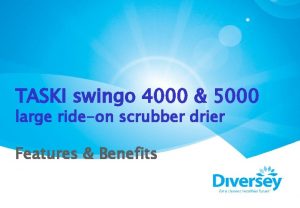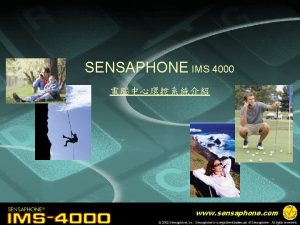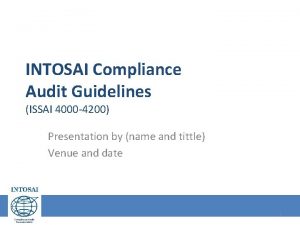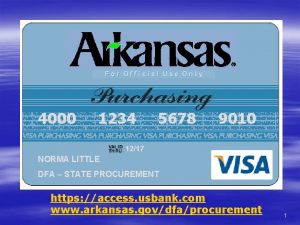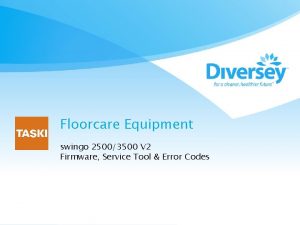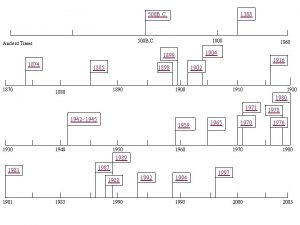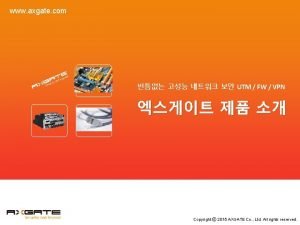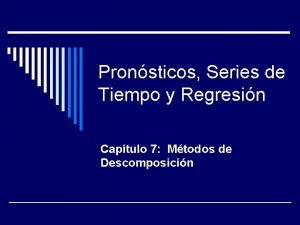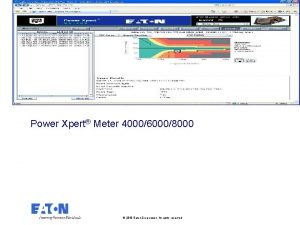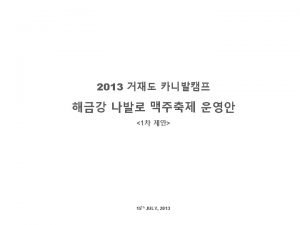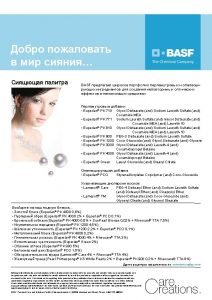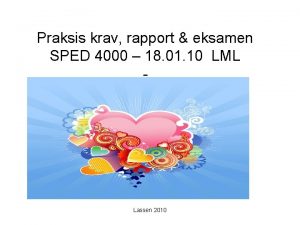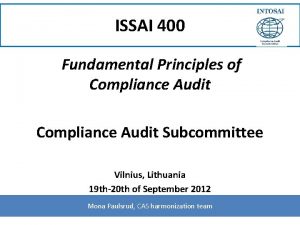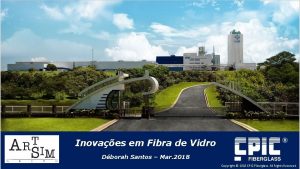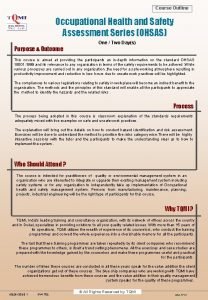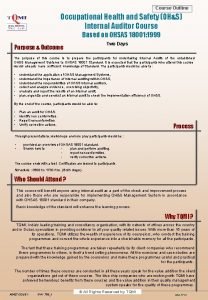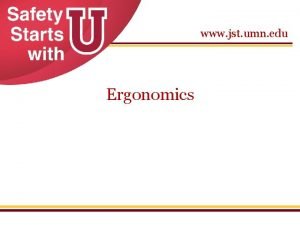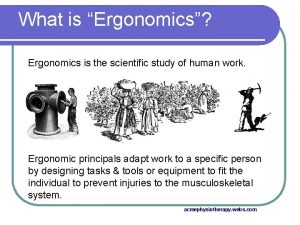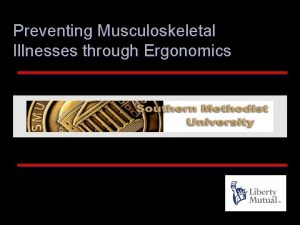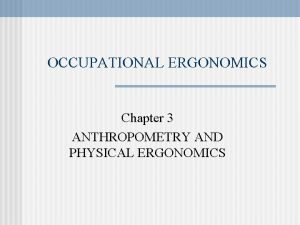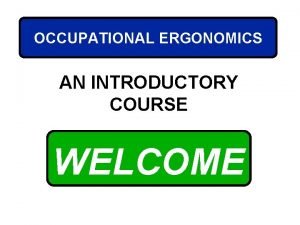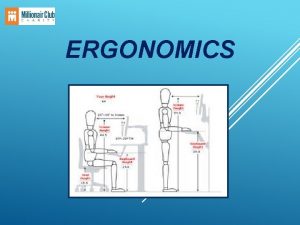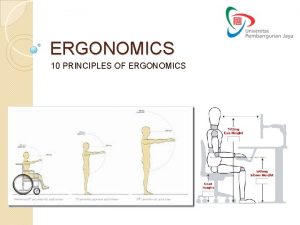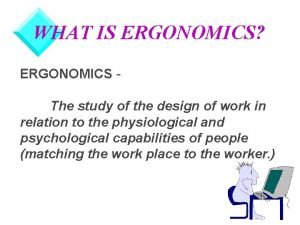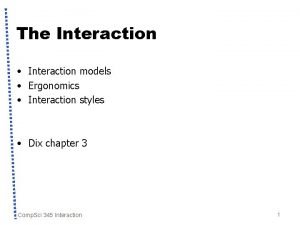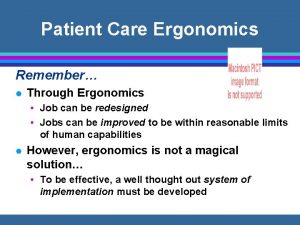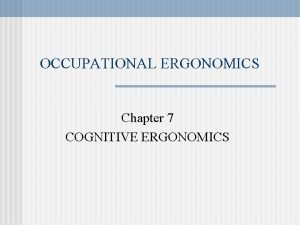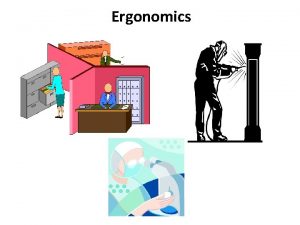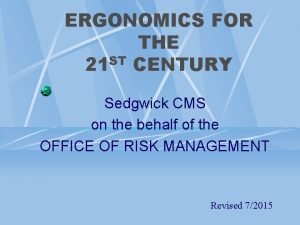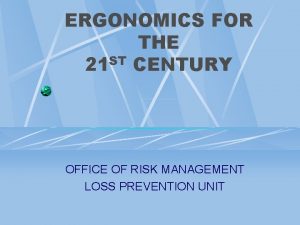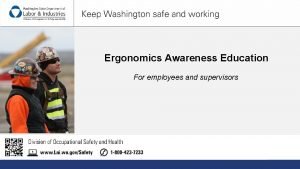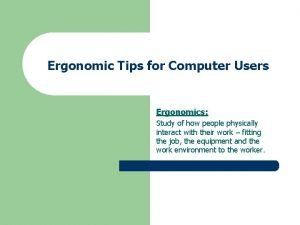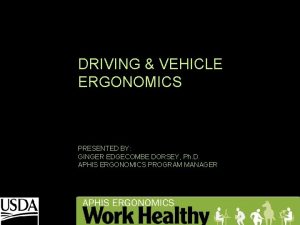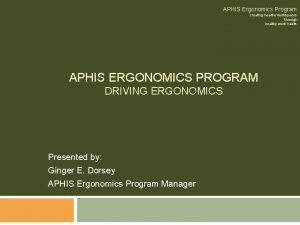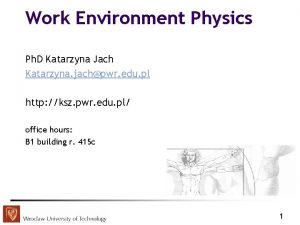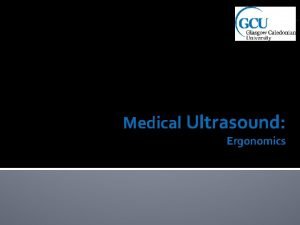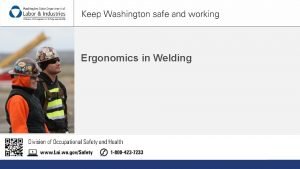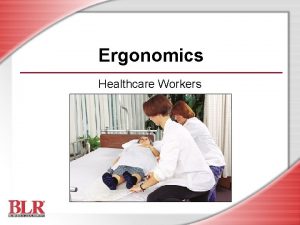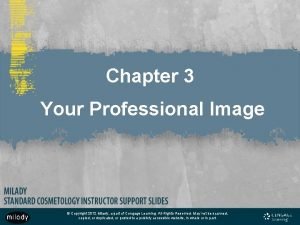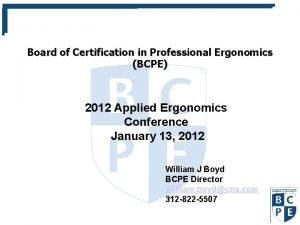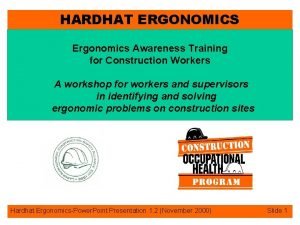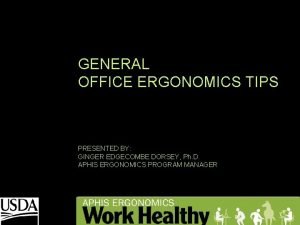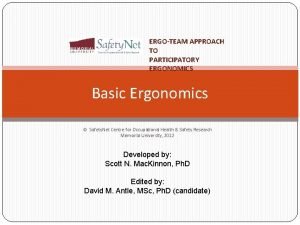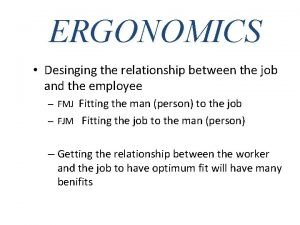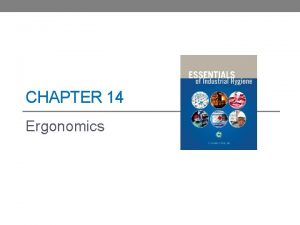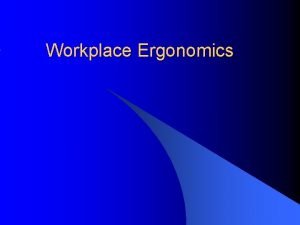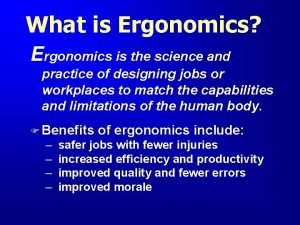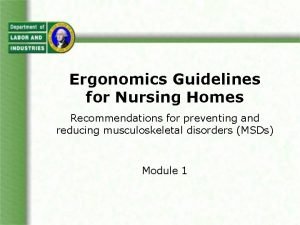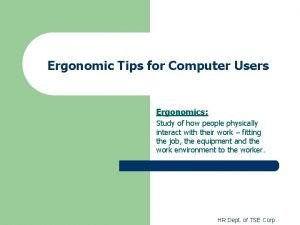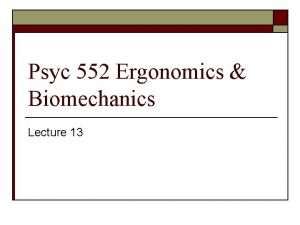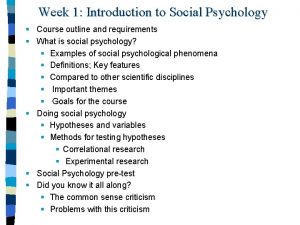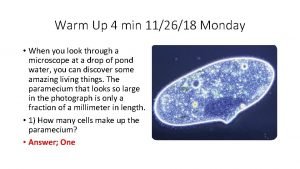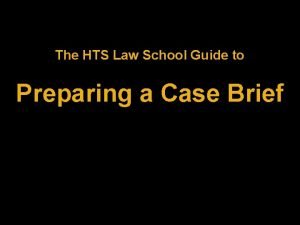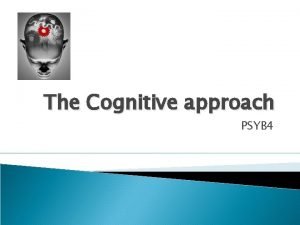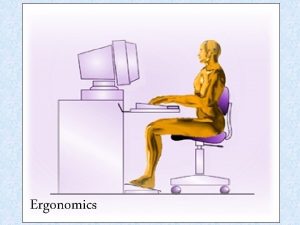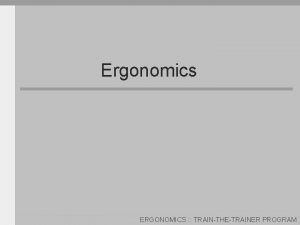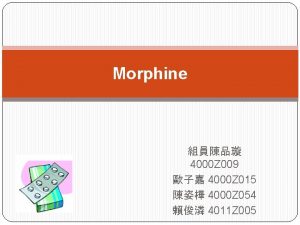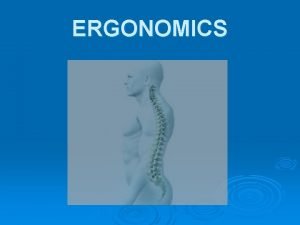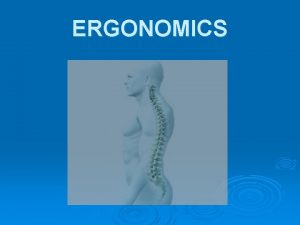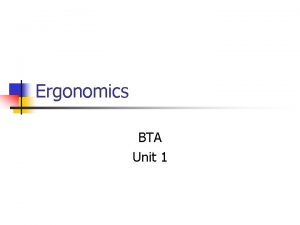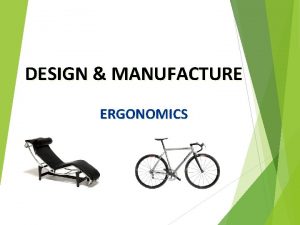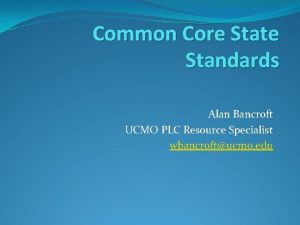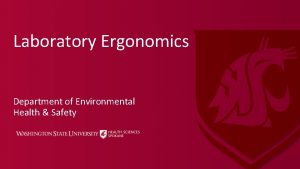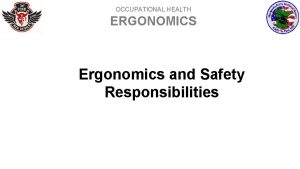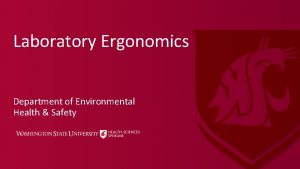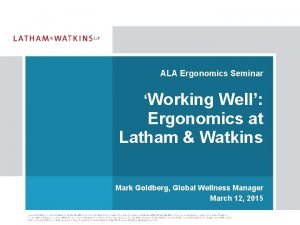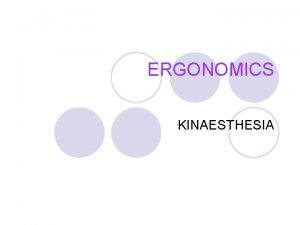Safety Ergonomics Safety 4000 UCMO Safety Ergonomics Outline












































































































































- Slides: 140

Safety Ergonomics Safety 4000 UCMO

Safety Ergonomics • Outline • • Industries Affected History of Ergonomics Future of Ergonomics Overall Health effects Lab Computer Workstation Evaluation of Hand tools Health effects of tools Final Examination and Practical Safety 4000, Ergonomics August 2008

Class Work • Practical Examination – workstation evaluation • Paper: Proposed Ergonomics standard • Quizes • Final Examination Safety 4000, Ergonomics August 2008

Paper • • • Suggested criteria/standard on ergonomics Specific Tool/process Follow OSHA Example Present or discuss your paper in class If you bring the tool, it’s worth extra credit. Safety 4000, Ergonomics August 2008

Paper Requirements • 5 -7 pages minimim • 3 References (NIOSH, CDC, OSHA) – Extra credit for additional references • Provide analysis • Industry Cost $$$$ • How many injuries will this standard prevent Safety 4000, Ergonomics August 2008

Paper Due: • 11 October 2008. • Advantage in early paper turn-in. • Comments? Safety 4000, Ergonomics August 2008

Practical • Perform an evaluation of Computer Workstation • Complete form • Provide Recommendations Safety 4000, Ergonomics August 2008

Final • About 25 Questions – Multiple-choice questions – Fill in the blank – 3 -4 Essay Questions – True/False Safety 4000, Ergonomics August 2008

Media* • Videos on Ergonomic Programs • Material is testable Safety 4000, Ergonomics August 2008

Texts: • The Ergonomics Edge: Dan Macleod. • Practical Ergonomics Safety 4000, Ergonomics August 2008

Ergonomics • You’re Experience? Safety 4000, Ergonomics August 2008

Questions? Safety 4000, Ergonomics August 2008

What Is Ergonomics? Fall 2006 SAFE 4000 Overview 13

Ergonomics • • Based on 2 words, ergo & nomos Ergo means laws or rules Nomos means work or strength Thus, ergonomics means laws of work Safety 4000, Ergonomics Fall 2006 August 2008 SAFE 4000 Overview 14

Ergonomics • 1950, “ergonomics” was coined by a group of British scientists • 1957 American Scientists working in the same discipline called themselves the Human Factors Society Safety 4000, Ergonomics Fall 2006 August 2008 SAFE 4000 Overview 15

Ergonomics Is. . . • • Engineering Tool Design out job hazards Eliminating causes Preventing accidents Safety 4000, Ergonomics Fall 2006 August 2008 SAFE 4000 Overview 16

Viewpoints on Ergonomics • Historic viewpoint - make people fit the job, e. g. , “The Jungle” Safety 4000, Ergonomics Fall 2006 August 2008 SAFE 4000 Overview 17

Viewpoints on Ergonomics • Current Viewpoint - make job fit the person Safety 4000, Ergonomics Fall 2006 August 2008 SAFE 4000 Overview 18

Ergonomic Definitions • Board of Certification in Professional Ergonomics – Body of knowledge about human abilities, human limitations, and other human characteristics that are relevant to design Safety 4000, Ergonomics Fall 2006 August 2008 SAFE 4000 Overview 19

Ergonomic Definitions • OSHA – Study of the design of requirements of work in relation to the physical and psychological capabilities and limitations of people Safety 4000, Ergonomics Fall 2006 August 2008 SAFE 4000 Overview 20

Keywords - FAR*LTV • Force • Awkward posture • Repetition {*3 most important risk factors} Safety 4000, Ergonomics Fall 2006 August 2008 SAFE 4000 Overview 21

Keywords - FARLTV (continued) • Lack of Rest • Temperature • Vibration Safety 4000, Ergonomics Fall 2006 August 2008 SAFE 4000 Overview 22

Body Tissues Affected • Soft Tissues – Nerves – Tendon Sheaths – Ligaments – Blood vessels Safety 4000, Ergonomics Fall 2006 August 2008 SAFE 4000 Overview 23

Body Tissues Affected • Bones – Spine, especially the lower portion of spine – lumbar region – Bones in fingers - white finger disease Safety 4000, Ergonomics Fall 2006 August 2008 SAFE 4000 Overview 24

Is Ergonomic a New Problem? Fall 2006 SAFE 4000 Overview 25

History - Bernardo Ramazzini –In 1700 this Italian physician wrote a text describing many occupational hazards –Included were problems that today we call cumulative trauma disorders (CTDs) Safety 4000, Ergonomics Fall 2006 August 2008 SAFE 4000 Overview 26

History - Bernardo Ramazzini –CTDs appeared in workers who did violent & irregular motions and assumed unnatural positions –Also noted problem for office workers! Safety 4000, Ergonomics Fall 2006 August 2008 SAFE 4000 Overview 27

History - Bernardo Ramazzini • He noted risk factors for office workers: – Repetitive hand motions – Constrained postures – Excessive mental stress Safety 4000, Ergonomics Fall 2006 August 2008 SAFE 4000 Overview 28

Early Tools… Dental Tools! Safety 4000, Ergonomics August 2008

History - Alice Hamilton • Dr. Alice Hamilton – Mother of Occup Medicine in US – Studied White Finger Disease (HAVS) in Indiana Limestone Quarry workers in the 1930’s Safety 4000, Ergonomics Fall 2006 August 2008 SAFE 4000 Overview 30

History - Erwin Tichauer • Dr. Tichauer – Taught at New York University – Developed concept of bending tool handle instead of the worker’s wrist – Wrote Chapter 32 of the NIOSH White Book, 1973 Safety 4000, Ergonomics Fall 2006 August 2008 SAFE 4000 Overview 31

Bend Tool Handle - Not Wrist Fall 2006 SAFE 4000 Overview 32


John Deer, 1837 Plow

Common Terms • • Washer Woman’s Sprain Gamekeepers Thumb Telegraphist’s Cramp Writer’s Cramp Safety 4000, Ergonomics Fall 2006 August 2008 SAFE 4000 Overview 35

Safety 4000, Ergonomics August 2008

Common Terms • • Trigger Finger Tennis Elbow Golfer’s Elbow Dunlaps Disease Safety 4000, Ergonomics Fall 2006 August 2008 SAFE 4000 Overview 37

Benefits of Improving Ergonomic Environment • Higher morale • Improved quality of work • Greater efficiency/Improved productivity Safety 4000, Ergonomics Fall 2006 August 2008 SAFE 4000 Overview 38

Benefits of Improving Ergonomic Environment • • Reduced absenteeism Lower turnover Fewer repetitive trauma disorders Fewer workers comp claims Safety 4000, Ergonomics Fall 2006 August 2008 SAFE 4000 Overview 39

Certification - Continued • BCPE - Board of Certification in Professional Ergonomics – First certifications in 1992 – CPE/CHFP – More recently developed Associates Certification Safety 4000, Ergonomics Fall 2006 August 2008 SAFE 4000 Overview 40

Ergonomics Focuses On • Accommodating information processing capabilities of the brain • Physical properties/constraints of body • Designing controls to minimize muscle fatigue Safety 4000, Ergonomics Fall 2006 August 2008 SAFE 4000 Overview 41

Ergonomics Consists Of • • • Engineering Physiology Medicine Anthropometrics Behavioral Science Safety 4000, Ergonomics Fall 2006 August 2008 SAFE 4000 Overview 42

Other Ergonomic Considerations • Psychological factors (attitudes) • Somatic factors (age) • Physiological factors (glucose, oxygen) Safety 4000, Ergonomics Fall 2006 August 2008 SAFE 4000 Overview 43

Other Ergonomic Considerations • Learning factors (knowledge) • Nature of work (intensity, duration) • Environment (heat, chemical exposure, noise) Safety 4000, Ergonomics Fall 2006 August 2008 SAFE 4000 Overview 44

Ergonomists Use A Systems Approach

Applying Systems Approach • Proactive - action taken before CTD occurs • Reactive - corrective action taken after CTD occurs Safety 4000, Ergonomics Fall 2006 August 2008 SAFE 4000 Overview 46

No two workers are identical • Equal height – different arm reach – different trunk height • Equal weight – different strengths – different heights Safety 4000, Ergonomics Fall 2006 August 2008 SAFE 4000 Overview 47

No two workers are identical • Design a workstation to accommodate 90 -95% of the working population Safety 4000, Ergonomics Fall 2006 August 2008 SAFE 4000 Overview 48

Design Considerations • Control/display design & location • Location/orient. of work surface • Guarding/warnings • Posture Safety 4000, Ergonomics Fall 2006 August 2008 SAFE 4000 Overview 49

Design Considerations • • Movements/repetitions Accessibility Machinery/equipment design Hand tool design Safety 4000, Ergonomics Fall 2006 August 2008 SAFE 4000 Overview 50

Design Considerations • Size/shape of work objects • Weight of work objects/equipment • Vibration Safety 4000, Ergonomics Fall 2006 August 2008 SAFE 4000 Overview 51

Amount of Physical Stress • • Force needed or weight handled Load location or posture Task repetition Duration of task Safety 4000, Ergonomics Fall 2006 August 2008 SAFE 4000 Overview 52

Ergonomic Factors For Worker Does employee stand or sit? Is employee stationary or mobile? Does job require great strength? Can reaching be done comfortably? • Are job tasks repetitive? • • Safety 4000, Ergonomics August 2008 53

Ergonomic Factors For Worker Control over pace of work? Tools properly fitted? Proper PPE used? Job environment uncomfortable? • Job boring to worker? • • Safety 4000, Ergonomics Fall 2006 August 2008 SAFE 4000 Overview 54

Anthropometry The study of the physical dimensions of the various parts of the human body (size, range of motion)

Anthropometry • Military has large sets of anthropometric data • More recently surveys of civilian populations have been conducted • In early part of 21 st Century, US Airforce initiated a large civilian anthropometric survey Safety 4000, Ergonomics Fall 2006 August 2008 SAFE 4000 Overview 56

Anthropometry • Ethnic differences can be significant: – North American males height ~1, 790 mm – Southern India males height ~1, 620 mm Safety 4000, Ergonomics Fall 2006 August 2008 SAFE 4000 Overview 57

How Big Is The Problem? • DOL (1982): – Back injuries were one of the most common & costly WRI – back injuries ~20 % of Inj. /Ill. – 1/4 of workers comp payments Safety 4000, Ergonomics Fall 2006 August 2008 SAFE 4000 Overview 58

How Big Is The Problem? • National Safety Council (1990) –overexertion accounted for 31% of all injuries –Back most frequently injured – 22% of 1. 7 million injuries Safety 4000, Ergonomics Fall 2006 August 2008 SAFE 4000 Overview 59

How Big Is The Problem? Current estimates are that 1/2 of workers comp claims are ergonomic-based Fall 2006 SAFE 4000 Overview 60

How Big Are The Bucks ($) • 1997 NIOSH - workers comp costs at 13 billion • 1999 NIOSH - associated costs are between 50 -100 billion • 1999 OSHA Basically agrees with the NIOSH estimated costs Safety 4000, Ergonomics Fall 2006 August 2008 SAFE 4000 Overview 61

Is this big bucks? YES! Fall 2006 SAFE 4000 Overview 62

Identifying Problem Areas • Review records • Walk through survey - spend time observing jobs • Analyze input from established to find problems Safety 4000, Ergonomics Fall 2006 August 2008 SAFE 4000 Overview 63

Record Review • CTD/back overexertion injuries • Determine trends • Identify factors for additional analysis Safety 4000, Ergonomics Fall 2006 August 2008 SAFE 4000 Overview 64

Worksite Analysis • Categories – Dept, job, shift, time, weekday, etc. – Type of injury, body part involved – Instrument of injury (e. g. , bin #, machine #) – Job experience, age of worker, gender, supervisor Safety 4000, Ergonomics Fall 2006 August 2008 SAFE 4000 Overview 65

Indicators of Ergonomic Problems • Work accidents are obvious indicators of ergonomic problems. • Other less obvious indicators exist Safety 4000, Ergonomics Fall 2006 August 2008 SAFE 4000 Overview 66

Less-Obvious Indicators of Ergonomic Problems • • Trends in accidents/injuries Absenteeism, high turnover rate Seasonal hiring pattern Employee complaints Safety 4000, Ergonomics Fall 2006 August 2008 SAFE 4000 Overview 67

Less-Obvious Indicators of Ergonomic Problems • Employee-generated workplace changes • Incentive pay systems • Excessive overtime Safety 4000, Ergonomics Fall 2006 August 2008 SAFE 4000 Overview 68

Less-Obvious Indicators of Ergonomic Problems • • • Increased work rate Poor product quality Manual material handling Repetitive motion tasks Improperly designed workstations Safety 4000, Ergonomics Fall 2006 August 2008 SAFE 4000 Overview 69

Employee Generated Changes • Added padding to tools or work surfaces • Altered seats and/or chairs • Makeshift platforms • Gets help to complete task • Modification of PPE Safety 4000, Ergonomics Fall 2006 August 2008 SAFE 4000 Overview 70

Employee Generated Changes • Shiny work surfaces – from contact with workers body • • Changed workflow design Modified illumination Modified ventilation Realigned tools, fixtures, or staging areas Safety 4000, Ergonomics Fall 2006 August 2008 SAFE 4000 Overview 71

Common CTDs • Carpal Tunnel Syndrome burning, tingling, itching in wrist or first 3 fingers & thumb Safety 4000, Ergonomics Fall 2006 August 2008 SAFE 4000 Overview 72

Common CTDs • Epicondylitis - (tennis elbow) inflammation of tissues on thumb side of elbow Safety 4000, Ergonomics Fall 2006 August 2008 SAFE 4000 Overview 73

Common CTDs • Hand Arm Vibration Syndrome (White Finger Disease) numbness, pain, blanching of fingers, loss of muscle strength, sensitive to heat & cold Safety 4000, Ergonomics Fall 2006 August 2008 SAFE 4000 Overview 74

Common CTDs • Thoracic Outlet Syndrome & Bursitis & Rotator Cuff Syndrome – affects nerves & muscles of upper arms & shoulders – Associated with overhead work Safety 4000, Ergonomics Fall 2006 August 2008 SAFE 4000 Overview 75

American with Disabilities Act Requires that feasible ergonomic accommodation for accessibility & adaptation to an individual’s particular disability be made to the workstation & surrounding areas Fall 2006 SAFE 4000 Overview 76

When Should You Identify Ergonomic Problems? • The sooner the better! • Incorporate ergonomic principles into design stage! Safety 4000, Ergonomics Fall 2006 August 2008 SAFE 4000 Overview 77

References • Jim Mc. Glothlin. Chapter 28 - Ergonomics. In: The Occupational Environment - Its Evaluation, Control & Management, AIHA 2003 • Tichauer ER. Ergonomic Aspects of Biomechanics. In: The Industrial Environment Its Evaluation & Control. NIOSH. 3 rd Edition 1973. (Produced via contract by George D. Clayton & Associates) • Kroemer, KHE. Ergonomics. Chapter 13. In Fundamentals of Industrial Hygiene. Barbara Plog, Editor. National Safety Council. 2002 Safety 4000, Ergonomics Fall 2006 August 2008 SAFE 4000 Overview 78

References • Ergonomics - A Practical Guide, 2 nd Edition, National Safety Council, 1993. • Fitting the Task To The Human. Kroemer Grandjean, 5 th Edition, 1997 • Words Of Wisdom & Personal Communication with Dr. Marvin Mills, Retired Ergonomic Professor. Lexington, KY. Safety 4000, Ergonomics Fall 2006 August 2008 SAFE 4000 Overview 79

History… • Ramazinni: 1633 -1714 • Wrote about work related complaints • Wojciech Jastrzebowski: Created the word Ergonomics in 1857 Safety 4000, Ergonomics August 2008

Ergonomics… • What is it? • Basic Confusion on Meaning • Different Definitions Safety 4000, Ergonomics August 2008

Ergonomics • Similar to Industrial Engineering • Similar to Human Factors Engineering – Computer Users – Meat Packers – Assembly line personnel – Nurses – Packagers – Construction – Agriculture Safety 4000, Ergonomics August 2008

History… • Ergonomics • Ergo - Work • Nomos - law Safety 4000, Ergonomics August 2008

Frank Gilbreth • Efficiency and Time-Motion Studies Safety 4000, Ergonomics August 2008

Safety 4000, Ergonomics August 2008

Safety 4000, Ergonomics August 2008

Early Pioneers • Frederick Taylor Safety 4000, Ergonomics August 2008

Safety 4000, Ergonomics August 2008

Workplace Changes - WWII • What effect? • Who was in workplace? • How was equipment designed? Safety 4000, Ergonomics August 2008

Safety 4000, Ergonomics August 2008

Safety 4000, Ergonomics August 2008

Workplace Adjustments • Ergonomics – Adjusting Workplace to worker Safety 4000, Ergonomics August 2008

Industries • Food Cashiers: Safety 4000, Ergonomics August 2008

Extent of Problem • 600, 000 Each Year (MSD) • 30% of Construction Events • $200 Billion to Fix (estimates) • $10 K person medical treatment

OSHA • New OSHA Standard • 1910. 900 (Died) • ANSI A 10. 40 -2700 Safety 4000, Ergonomics August 2008

The Result? • Type Injuries • (Muscularskeletal Disorders, MSD) Safety 4000, Ergonomics August 2008

MSD • • Carpal Tunnel Syndrone Back injury (Lumbar) Shower (rotator cuff bursititis) Washer Knee Safety 4000, Ergonomics August 2008

Medical Effects: Safety 4000, Ergonomics August 2008

Construction… Safety 4000, Ergonomics August 2008

Work Related Musculoskeletal Disorders

Upper Extremity Disorders n n n n n Carpel tunnel syndrome Cubital tunnel syndrome Thoracic outlet syndrome Raynaud’s syndrome (white finger) Rotator cuff syndrome De. Quervain’s disease Tendinitis Tenosynovitis Trigger finger Ganglion cyst

Neurovascular Disorders • Carpal Tunnel Syndrome – Impingement of the median nerve caused by irritation and swelling of the tendons in the carpal tunnel • Cubital Tunnel Syndrome – Pressure on the ulnar nerve when the elbows are exposed to hard surfaces Safety 4000, Ergonomics August 2008

Neurovascular Disorders • Thoracic Outlet Syndrome – Compression of the blood vessels between the neck and shoulder caused by reaching above shoulder level or carrying heavy objects • Raynaud’s Syndrome – Also known as Vibration White Finger ; Blood vessels of the hand are damaged (narrowed) from repeated exposure to vibration for long periods of time Safety 4000, Ergonomics August 2008

Tendon Disorders • Rotator Cuff Syndrome • De. Quervain’s Disease – Combination of tendinitis and tenosynovitis • Tendinitis – Irritation of the tendon • Tenosynovitis – Irritation of the synovial sheath • Ganglion Cyst Safety 4000, Ergonomics – Accumulation August 2008 of fluid within the tendon sheaths

Tendinitis Safety 4000, Ergonomics August 2008

Hand Wrist Safety 4000, Ergonomics August 2008

Common Occupational CTDs of the Upper Extremities Carpal Tunnel Syndrome occurs from chronic swelling of the flexor tendons in the wrist. The median nerve, which feeds the first three fingers and the thumb, can become impaired from pressure in the carpal tunnel in the wrist. Symptoms include: · pain in the first three fingers and the thumb · numbness in these areas · tingling in these areas

Carpal Tunnel Syndrome


Carpal Tunnel Syndrome

Common Occupational CTDs of the Upper Extremities Raynaud’s Syndrome is when blood vessels of the hand are damaged (narrowed) from repeated exposure to vibration for long periods of time This is connected with use of vibrating tools, such as hair clippers and jack hammers.

Raynaud’s Syndrome Symptoms n n Numbness and tingling in the fingers during vibration exposure; may continue after exposure has been discontinued Blanching (whitening) of one fingertip because of a temporary constriction of blood flow Other fingers also blanch Intensity of pain & frequency of attacks increase in time

Common Occupational CTDs of the Upper Extremities Cubital Tunnel Syndrome is caused by resting the elbows on hard surfaces such as unpadded tables or armrests. The ulnar nerve, which feeds the ring and little fingers, can become impaired from pressure near the elbows. Symptoms include: · pain in the ring and little fingers · tingling in these areas · numbness in these areas

Cubital Tunnel Syndrome

Common Occupational CTDs of the Upper Extremities Thoracic Outlet Syndrome is caused by frequent reaching above shoulder level, by carrying heavy objects, or posture involving a forward head tilt. A Neurovascular bundle called the brachial plexus, which passes between the collar bone and the top rib, can become impaired from pressure associated with movements that causes these two bones to be positioned close together. Symptoms include: · the arms “falling asleep” · weakened pulse · numbness in the fingers

Thoracic Outlet Syndrome

Common Occupational CTDs of the Upper Extremities Rotator cuff syndrome is a disorder involving swelling and pain of tendons comprising the rotator cuff muscle group: subscapularis, supraspinatus, infraspinatus, & teres minor Symptoms include: • Pain when you bend the arm and rotate it outwards against resistance • Pain on the outside of the shoulder possibly radiating down into the arm • Pain in the shoulder, which is worse at night • Stiffness in the shoulder joint.

Rotator Cuff Syndrome Anterior View Posterior View

Common Occupational CTDs of the Upper Extremities Tendinitis is a common CTD for the wrist, elbow, and shoulder. It occurs when we continually stress the tendon cables, causing them to become irritable and sore. Lateral Epicondylitis - “Tennis elbow” Medial Epicondylitis - “Golfer’s elbow” Symptoms include: · point tenderness · swelling · tennis elbow, pain radiates down to back of hand · golfer’s elbow, pain radiates down to back of hand

Tendinitis

Common Occupational CTDs of the Upper Extremities Tenosynovitis is swelling of the sheath that covers the tendon from constant rubbing against the tendon. Symptoms include: swelling pain loss of motion loss of strength

Tenosynovitis

Common Occupational CTDs of the Upper Extremities Trigger Finger is a tendon disorder that occurs when there is a groove in the flexing tendon of the finger If the tendon becomes locked in the sheath, attempts to move the finger cause snapping or jerking movements Usually associated with using tools that have handles with hard or sharp edges.

Trigger Finger Safety 4000, Ergonomics August 2008

Common Occupational CTDs of the Upper Extremities Ganglion Cyst is a bump under the skin caused by an accumulation of fluid within the tendon sheath. It is commonly found at the hand wrist. Safety 4000, Ergonomics August 2008

Ganglion Cyst Safety 4000, Ergonomics August 2008

Common Occupational CTDs of the Upper Extremities De Quervain’s Disease is an inflammation of the tendon sheath of the thumb attributed to excessive friction between two thumb tendons and their common sheath. It’s a combination of Tendonitis and Tenosynovitis. May be caused by twisting and forceful gripping Symptoms include: • swelling • pain at the base of the thumb.

De Quervain’s Disease

De Quervain’s Disease

Prospective Study of Computer Users Fredric Gerr, et. al. , 2002, “A Prospective Study of Computer Users: 1. Study Design and Incidence of Musculoskeletal Symptoms and Disorders”. – 632 individuals – Newly hired into jobs requiring 15 hr/week of computer use – Were followed for up to 3 years Safety 4000, Ergonomics August 2008

Primary Results • Hand/Arm (H/A) & Neck/Shoulder (N/S) MSS and MSD were common among computer users • More than 50% of users reported MSS during the 1 st year after starting a new job • Most common H/A disorder was De. Quervain’s tendonitis • Most common N/S disorder was somatic pain syndrome Safety 4000, Ergonomics August 2008

Common Occupational Injuries of the Back Strains and sprains are damage to the tendons and ligaments caused by one time exertions such as lifting or carrying heavy objects. These can lead to very noticeable back pain, but the pain usually begins to subside within a few days

Common Occupational CTDs of the Back Facet joint pain results from irritation of the area where the ribs meet the spinal column. Typically, there is muscle swelling in the affected area and it can become very painful to sit or stand up straight. In some cases it may also be difficult to breath deeply. Safety 4000, Ergonomics August 2008

Common Occupational CTDs of the Back Disk erosion occurs from prolonged pressure on the spinal disks, which causes them to become permanently compressed. The space between the vertebrae becomes smaller, which can lead to impingement of the nerve roots leading out from the spine. Sitting puts more pressure on the spinal disks than standing, and sitting with the back unsupported can lead to high levels of disk pressure.

Disc Erosion

Common Occupational CTDs of the Back Sciatic nerve impingement, also called sciatica, is common for people who sit for prolonged periods of time. The sciatic nerve runs from your lower back down the back of your leg and into to your feet. Swelling in certain muscles in the buttocks can put pressure on the sciatic nerve, causing pain down the leg.

Common Occupational CTDs of the Back Herniated discs occur when the inner portion of the disc protrudes, putting pressure on the nerve roots leading from the spine. Pain or numbness in the legs is a common symptom of herniated discs in the lower back. Safety 4000, Ergonomics August 2008

Herniated/Bulging Disc


Break
 Sandwich quotes examples
Sandwich quotes examples Erlphase
Erlphase Erlphase
Erlphase Taski swingo 4000
Taski swingo 4000 Ims-4000
Ims-4000 Engineering108
Engineering108 Lb to kg equation
Lb to kg equation Nearly 4000 minerals have been named
Nearly 4000 minerals have been named Issai 4000
Issai 4000 Issai 4000 pdf
Issai 4000 pdf 4000 bc-3000 bc primitive times
4000 bc-3000 bc primitive times 1234 5678 9010
1234 5678 9010 Taski service tool download
Taski service tool download Mobro 4000
Mobro 4000 Axgate 2300
Axgate 2300 Polarn 4000
Polarn 4000 Numberblocks support materials
Numberblocks support materials Tj invested $4000
Tj invested $4000 Lam ds 4000
Lam ds 4000 Tj invested $4000
Tj invested $4000 Geombang
Geombang 1000000/4000
1000000/4000 Nearly 4000 minerals have been named.
Nearly 4000 minerals have been named. John's parents deposited $1000
John's parents deposited $1000 Tesla dfr
Tesla dfr 1500000/6000
1500000/6000 Descomposición multiplicativa
Descomposición multiplicativa Pxm8000
Pxm8000 Bud light canopy
Bud light canopy 4000/22/8
4000/22/8 It was introduced by thomas cook in 1867
It was introduced by thomas cook in 1867 Ision ip 4000
Ision ip 4000 Nearly 4000 minerals have been named
Nearly 4000 minerals have been named Euperlan pk 3000
Euperlan pk 3000 4000 calories scalar or vector
4000 calories scalar or vector 9000 8000
9000 8000 Clear my path neato
Clear my path neato Wizard 4000
Wizard 4000 Tables 11 to 25
Tables 11 to 25 Roman numerals 4000 to 5000
Roman numerals 4000 to 5000 4000-1680
4000-1680 Donau soja
Donau soja 3800 million years ago
3800 million years ago 4000/18
4000/18 Ogib na pukotini
Ogib na pukotini 60000000/4000
60000000/4000 Issai 4200
Issai 4200 Dborah
Dborah Heller h 4000
Heller h 4000 20000000/4000
20000000/4000 Die sojabohne
Die sojabohne Amprobe at-4000
Amprobe at-4000 Occupational health and safety course outline
Occupational health and safety course outline Occupational health and safety course outline
Occupational health and safety course outline Umn ergonomics
Umn ergonomics Workplace environment and ergonomics
Workplace environment and ergonomics Types of ergonomics
Types of ergonomics Ergonomic lifting techniques
Ergonomic lifting techniques Ergonomics and anthropometrics
Ergonomics and anthropometrics Ergonomicsl
Ergonomicsl Types of ergonomics
Types of ergonomics Objectives of ergonomics
Objectives of ergonomics Ergonomics case study
Ergonomics case study What are the objectives of ergonomics
What are the objectives of ergonomics Ergonomics in textile industry
Ergonomics in textile industry Ergonomics bathroom
Ergonomics bathroom Ergonomir
Ergonomir Six pillars of ergonomics
Six pillars of ergonomics What is ergonomics
What is ergonomics Slip human error
Slip human error Patient care ergonomics
Patient care ergonomics Types of ergonomics
Types of ergonomics Ferro foundries pvt ltd
Ferro foundries pvt ltd Visual display ergonomics
Visual display ergonomics Cms ergonomics
Cms ergonomics Types of ergonomics
Types of ergonomics Ergonomics awareness training for supervisors
Ergonomics awareness training for supervisors Ergonomics awareness training for supervisors
Ergonomics awareness training for supervisors Ergonomic tips for computer users
Ergonomic tips for computer users Controller ergonomics
Controller ergonomics Driving ergonomics checklist
Driving ergonomics checklist Wsfcs atkins
Wsfcs atkins Healthy workspaces
Healthy workspaces Katarzyna jach
Katarzyna jach Objectives of ergonomics
Objectives of ergonomics Ultrasound ergonomics
Ultrasound ergonomics Ergonomics in welding
Ergonomics in welding Ergonomics for healthcare workers
Ergonomics for healthcare workers Milady professional image
Milady professional image Https://iehf.org/web-design-ergonomics-checklist/
Https://iehf.org/web-design-ergonomics-checklist/ Find ergonomics awareness training
Find ergonomics awareness training Office ergonomics
Office ergonomics Ergoteam
Ergoteam Ergonomics definition
Ergonomics definition Objectives of ergonomics
Objectives of ergonomics What is ergonomics
What is ergonomics Ergonomics is the science of
Ergonomics is the science of Ergonomics in human computer interaction
Ergonomics in human computer interaction Ergonomics
Ergonomics Ergonomic exercises for computer users
Ergonomic exercises for computer users Physiology ergonomics
Physiology ergonomics Objectives of ergonomics
Objectives of ergonomics Ecdis safety settings
Ecdis safety settings Safety care training
Safety care training Personal safety vs process safety
Personal safety vs process safety Ind safety report
Ind safety report Basic safety (construction site safety orientation)
Basic safety (construction site safety orientation) 00101-15 basic safety
00101-15 basic safety Poetry precis
Poetry precis How to write an leq
How to write an leq Comparison and contrast outline
Comparison and contrast outline Sociocultural psychology examples
Sociocultural psychology examples Lesson outline lesson 3 describing circuits answers
Lesson outline lesson 3 describing circuits answers Brainpop protists
Brainpop protists Outline of the book of numbers
Outline of the book of numbers The visual and artistic aspects of presenting a product
The visual and artistic aspects of presenting a product Kind of fault
Kind of fault Lesson outline lesson 2 aquatic ecosystems answer key
Lesson outline lesson 2 aquatic ecosystems answer key Desire for power enduring issue
Desire for power enduring issue Hackathon presentation template
Hackathon presentation template Army aar questions
Army aar questions Psalm 61 sermon outline
Psalm 61 sermon outline Psalm 46 sermon outline
Psalm 46 sermon outline Psalm 40 sermon
Psalm 40 sermon Pathology outline
Pathology outline Thesis outline example
Thesis outline example Jesus vs ganesha
Jesus vs ganesha Toulmin argument essay outline
Toulmin argument essay outline What is a synthesis essay
What is a synthesis essay Colossians 4 2
Colossians 4 2 Mandt side body hug
Mandt side body hug Presentation outline slide
Presentation outline slide Law school case brief template
Law school case brief template 2 corinthians outline
2 corinthians outline 2 corinthians outline
2 corinthians outline Outline of 1 corinthians
Outline of 1 corinthians Cognitive approach definition
Cognitive approach definition Joel outline
Joel outline Outline of joel
Outline of joel Evangelism explosion outline
Evangelism explosion outline Kings outline
Kings outline



